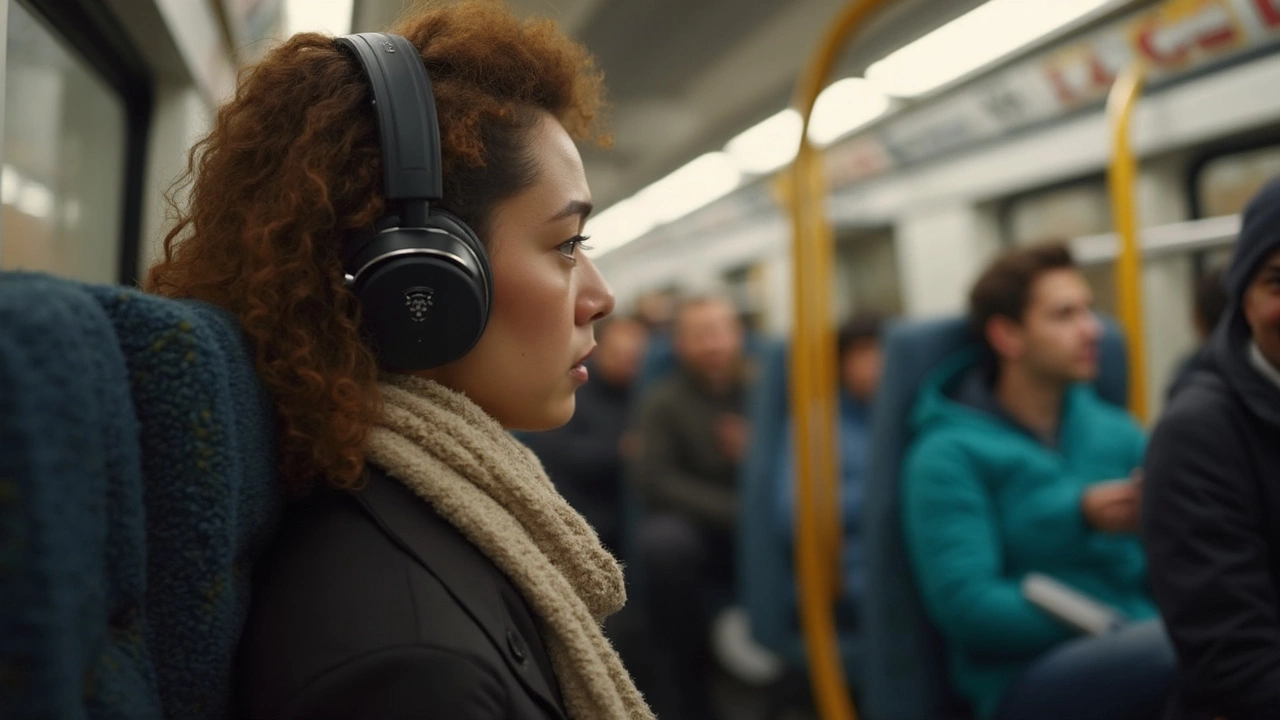Ever sat on a busy train and wondered why your headphones barely cut out the chatter? Or maybe you tried a high-end pair and thought, how did that annoying hum suddenly slam to silence? Turns out, ‘noise reduction’ and ‘noise cancelling’ aren’t just buzzwords—they’re two different beasts. Mix them up, and you might get less peace and quiet than you hoped for.
Getting these terms straight can save you cash and a headache. Noise reduction usually means the headphones just block stuff out physically—think of ear muffs for your ears. Noise cancelling means the headphones actually listen to the noise around you and create anti-noise to wipe it out. Sounds nerdy, but the difference hits hard, especially if you commute or work in a loud office.
- How Noise Reduction Works in Headphones
- Inside Noise Cancelling: The Science and Magic
- Real-Life Scenarios: Which Tech Wins?
- Tips for Choosing the Right Headphone Feature
How Noise Reduction Works in Headphones
Let’s keep it simple: noise reduction in headphones means blocking out sound using just physical design. Most headphones that offer this rely on what’s called passive noise reduction. They don’t need batteries, power, or electronics—just good old-fashioned materials and smart shapes.
This is where things like thick ear pads, tight seals, and solid cups come into play. Over-ear headphones, for example, wrap around your ear and use cushy padding to block out a bunch of outside noise. Earbuds can help too, especially if they fit snugly in your ear canal. It’s pretty much the headphone version of shutting the window to keep street noises out.
The trick is all in the build. Headphones with better noise-reducing features usually have:
- Thicker foam or memory foam padding
- Closed-back (not open-back) cups
- A tighter, but still comfy, fit
- Materials that don’t let sound pass through easily (like dense plastics and synthetic leather)
One study done in 2022 showed that passive noise reduction can cut background noise by 15 to 25 decibels depending on the fit and materials. That’s a big difference—imagine lowering a city’s daily hum to a quieter suburb.
| Headphone Type | Average Noise Reduction (dB) |
|---|---|
| Over-ear (closed-back) | 20-25 |
| In-ear (good seal) | 18-22 |
| On-ear (basic padding) | 12-18 |
Keep in mind, even the best passive noise reduction headphones can’t magically erase loud and low constant noises—like the roar of a jet engine or rumble of bus tires. But for regular chatter, AC buzz, or keyboard clicking, they work surprisingly well without needing charging or complicated tech.
Inside Noise Cancelling: The Science and Magic
Noise cancelling sounds almost like a sci-fi trick, but there’s real tech doing the heavy lifting. These headphones actually use little microphones to listen to outside sounds—the growl of a bus, the AC’s whine, maybe your neighbor’s epic keyboard slamming in the next cubicle. Then, a tiny sound processor takes what the mics hear and cooks up sound waves that reverse the incoming noise. This anti-noise hits your ears at the same time as the real noise, and the two basically wipe each other out. That’s what makes everything go quiet—like a mute button for the world outside.
There are two main types: active and adaptive. Active noise cancelling (ANC) does what I just explained—listens, processes, and counters steady noise. Adaptive ANC takes it up a notch. It senses how much noise is out there, checks how well your headphones are sealed on your head, and tweaks the cancelling on the fly. If you turn your head or get on a louder train, it automatically adjusts. Some of the newest headphones drop background noise by up to 40 decibels—think cutting city traffic down to a whisper.
But this tech isn’t magic. It’s best at tackling steady, low sounds—like engines, ventilation, or distant chatter. Sudden, sharp sounds like clapping or barking? Those often slip through. Plus, noise cancelling runs on batteries. Some models can do 20-30 hours on a full charge, but every feature you turn on chips away at battery life.
Check out how the numbers stack up in some brand-name headphones on the market right now:
| Headphone Model | Max Noise Cancelling (dB) | Battery Life with ANC (hours) |
|---|---|---|
| Sony WH-1000XM5 | Up to 40 | 30 |
| Bose QuietComfort Ultra | Up to 35 | 24 |
| Apple AirPods Max | Up to 30 | 20 |
If you’re serious about shutting out noise, noise cancelling tech is the clear winner. It’s why you’ll see business travelers, gamers, and even some hardcore home office folks swear by it. Just remember: the pricier the headphone doesn’t always mean the better the cancellation—read user reviews, test them if you can, and don’t forget to look at battery stats before you hand over your credit card.

Real-Life Scenarios: Which Tech Wins?
Let’s get practical. Imagine you’re flying long-haul to visit family. The engine's constant drone quickly gets on your nerves. Here’s where noise cancelling headphones totally outshine regular noise reduction. These headphones use built-in microphones to catch low, steady sounds like airplane engines and use clever electronics to cancel them out. Bose claimed in a 2023 report that their QuietComfort line can reduce airplane cabin noise by up to 90%—you really hear the difference when you take them off mid-flight.
What about the open-plan office, that jungle of keyboard tapping, phone chats, and coffee machine gurgles? Noise cancelling can knock out steady background hums, but sudden noises slip through. Noise reduction headphones, which just cover your ears snugly, help block these sharper sounds, but you’ll still pick up most conversations.
Out and about walking in the city, noise cancelling can make you almost forget the traffic. But it's worth noting that most headphones let in some sound for safety reasons—you wouldn't want to miss a blaring horn. Some brands like Sony and Apple even offer a “transparency mode” so you can hear what’s going on around you with a tap.
Check out how each tech holds up in different situations:
| Scenario | Noise Reduction | Noise Cancelling |
|---|---|---|
| Airplane travel | Fair | Excellent |
| Busy office | Good (for sudden sounds) | Decent (for steady hums) |
| Walking outside | Basic | Good (plus safety features) |
| Studying in a café | Fair | Great |
A recent article from
"ANC technology has transformed how we escape noise in our daily environments, but it isn't magic. Strong low rumbles disappear, but shouty coworkers still sneak through." — The Verge, January 2024That about sums it up. So before swiping your card, think where you’ll use your headphones most and what type of racket drives you up the wall.
Tips for Choosing the Right Headphone Feature
If you’re tired of squinting at product packaging, wondering if 'noise reduction' or 'noise cancelling' is actually worth your money, join the club. Here’s a straight-up way to make the best choice for your daily routine—not just what sounds fancy.
- Noise cancelling headphones pack serious tech. If you fly often, work in open offices, or hate the roar of city buses, these are your jam. The best models cut up to 80-90% of steady background hum. Active noise cancelling (ANC) headphones by brands like Bose and Sony use built-in microphones to analyze surrounding noise.
- For simple comfort or blocking out basic noise—like coworkers typing or your neighbor’s TV—passive noise reduction works. Think thick, cushy ear pads, not digital wizardry. Both over-ear and in-ear options can tone down annoying sound, but they won’t erase it.
- Battery life is everything with ANC. Some headphones last just 12 hours, others up to 40. If you forget to charge, ANC dies and you’re left with regular headphones.
- Look at weight and pressure. In-ear buds with ANC can get uncomfortable for long use, especially if you have sensitive ears. Over-ear models can clamp down a bit.
- Don’t overpay. Noise reduction headphones cost less, sometimes under $50. Good ANC headphones can hit $250-400. Know your budget and don’t get sucked in by features you won’t use.
| Feature | Noise Reduction | Noise Cancelling |
|---|---|---|
| Best Use | Cafes, libraries | Planes, trains, busy offices |
| Price Range | $20-$120 | $90-$400 |
| Requires Power | No | Yes (for ANC) |
| Blocks Human Voices | Low | Medium to High |
| Hisses/Artefacts | No | Sometimes, depending on model |
Here’s a tip: Some headphones offer both features, so check the box for 'hybrid' models. If you mainly want music without spending a fortune, standard noise reduction probably does the trick. If you crave silence, even when people are talking or engines drone, ANC is the way to go.
Take your time at the store and try different pairs on. My cat Luna hates loud noises—she'd pick ANC every time. But if you’re just dodging distractions at your local café, save your wallet and stick with the basics.

